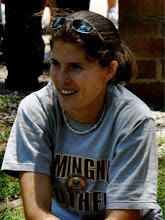
That being said, last Saturday was not quite as uneventful as the previous couple had been. I ended up going with Tyler and Seth out to Wichanzao (the area of town where the clinic is) to climb the mountain Serro de Cabros that had been teasing and enticing us since the first time the smog and clouds cleared out enough to tell that there are actually mountains around Trujillo. Despite loving not having to do things on the weekends, it was really nice to get out and do something a little different. Like the rest of this area, the mountain is extremely dry. In fact, it's pretty much all sand, rock, and shale. It's stark and looming (although not incredibly high), and its steep areas and lack of green make it look like the set of an old western movie where you might expect a pack of cowboys to come galloping by in a cloud of dust.
 I think we took the hard way, at least at the beginning as we clambered between huge rock structures, but even when we reached the
I think we took the hard way, at least at the beginning as we clambered between huge rock structures, but even when we reached the more open (but still steep) spaces higher up, the paths that seemed evident from the bottom where hard to find. I guess the slightly different shade of dirt that makes them visible isn't as easy to distinguish when you see it up close. (I'm sure there's a profoud metaphor somewhere in there). The only live things we saw were a few bugs, a couple of lizards, a struggling cactus, a bunch of snail-like creatures that looked like you should have found them at the beach, and a tiny, scrawny coyote that scrambled past a few dozen yards below us when we were taking a break.
more open (but still steep) spaces higher up, the paths that seemed evident from the bottom where hard to find. I guess the slightly different shade of dirt that makes them visible isn't as easy to distinguish when you see it up close. (I'm sure there's a profoud metaphor somewhere in there). The only live things we saw were a few bugs, a couple of lizards, a struggling cactus, a bunch of snail-like creatures that looked like you should have found them at the beach, and a tiny, scrawny coyote that scrambled past a few dozen yards below us when we were taking a break.Despite the stark environment, it was beautiful in its own way. And arriving at the top you could look one way and see how expansive Trujillo actually is, with houses and buildings flung for miles east toward the ocean (which we couldn't see because of the haze). The amazing part, though, was looking west. From the top you could see more mountains that aren't visible from the bottom of the mountain or through the haze of the city. But above it all, looking at their beauty (even more impressive and imposing than our "Goat Mountain"), it was exciting to think about how far they stretch. I'm not sure that these are even technically part of the Andes. Maybe they're just the beginning, but it sure made you wonder what beauty and adventure lies beyond what you can see. Sounds a little like Pocahontas... :)


One of my favorite parts was actually getting to the mountain. You had to walk a good 20 or 30 minutes through Wichanzao and then the poorer area of Clementina to reach the base of the mountain. It was really interesting and eye-opening to walk through the area where people lived, to get a glimpse of the reality - even if from outside their walls - of what life is like for these Peruvians. It's probably similar to that of many people I see in the clinic every day. It's by no means the poorest place in the world, but it's still a reality check. Kids playing soccer, dozens of dogs wandering around, women washing and hanging clothes, people bringing buckets of water...just another Saturday. And equally - if not more - beautiful here.



Your photos and description remind me of the Sonora desert in southern Arizona and just across the border in Nogales. Thank you, Lydia, for describing the scenery and your emotions as you "live" in Peru.
ReplyDeleteWow! Love the mountain-climbing picture-- and your desciption of the surrounding area. Are you sure you don't want to be a writer when you grow up?
ReplyDeleteAunt Cathy
YAY! You're already mountain climbing. Just remember in the wise words of a nashville teen, "It's the cliiiimmmbb!" Haha. The pictures are beautiful. So glad to hear you're both resting and adventuring.
ReplyDelete